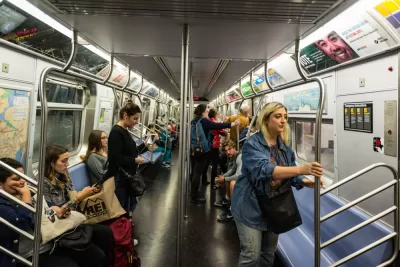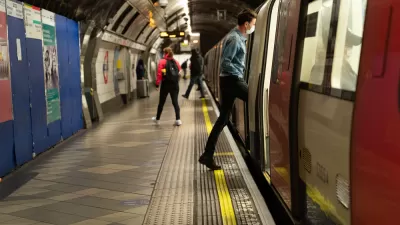As the coronavirus continues to move across the globe, its effects on shared transportation modes and freight shipping are becoming more apparent.

The coronavirus is affecting global transportation networks, with public transportation and air travel hit especially hard. The impacts in Chinese cities portend what could be coming to other parts of the world as the virus continues to spread.
"In Shanghai and Beijing, which are not subject to quarantine, ridership on their metro systems are down 85 percent and 91 percent, respectively (Check out the full data table here.) Intercity rail trips have dropped more than 80 percent. Domestic airlines cut 13,000 daily flights within the country and some desperate ones are offering $4 fares," writes Paul Lewis.
Research suggests that public transit is not where people are infected, and the work and social sites that people use transit to reach are the concern. Still, transit agencies are preparing systems, says Lewis. "[They] are investing millions of dollars for masks, signage, and disinfectant supplies to enable continue operations during a potential outbreak. Private companies are also implementing policies to ensure the safety of their employees and customers."
The coronavirus pandemic is also highlighting the interconnectedness of the global supply chain as freight shipping delays affect manufacturing around the world. "Such disruptions will have short term effects on the ability to sell products, but in the long run could force companies to rethink supply chains exposed to epidemic risks," adds Lewis.
FULL STORY: The Effects of Coronavirus on Transportation

Trump Administration Could Effectively End Housing Voucher Program
Federal officials are eyeing major cuts to the Section 8 program that helps millions of low-income households pay rent.

Planetizen Federal Action Tracker
A weekly monitor of how Trump’s orders and actions are impacting planners and planning in America.

Ken Jennings Launches Transit Web Series
The Jeopardy champ wants you to ride public transit.

Crime Continues to Drop on Philly, San Francisco Transit Systems
SEPTA and BART both saw significant declines in violent crime in the first quarter of 2025.

How South LA Green Spaces Power Community Health and Hope
Green spaces like South L.A. Wetlands Park are helping South Los Angeles residents promote healthy lifestyles, build community, and advocate for improvements that reflect local needs in historically underserved neighborhoods.

Sacramento Plans ‘Quick-Build’ Road Safety Projects
The city wants to accelerate small-scale safety improvements that use low-cost equipment to make an impact at dangerous intersections.
Urban Design for Planners 1: Software Tools
This six-course series explores essential urban design concepts using open source software and equips planners with the tools they need to participate fully in the urban design process.
Planning for Universal Design
Learn the tools for implementing Universal Design in planning regulations.
Heyer Gruel & Associates PA
Ada County Highway District
Institute for Housing and Urban Development Studies (IHS)
City of Grandview
Harvard GSD Executive Education
Toledo-Lucas County Plan Commissions
Salt Lake City
NYU Wagner Graduate School of Public Service




























